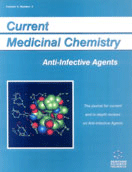Abstract
Peptide deformylase (PDF) has emerged as one of the most promising new targets for antimicrobial chemotherapy. PDF is an essential bacterial metalloenzyme that deformylates the N-formylmethionine of newly synthesised bacterial polypeptides. Although the enzyme has been known for over 30 years, it has proved difficult to isolate and characterise due to its apparent instability. However, recent progress in understanding the structure and function of PDF has greatly facilitated the drug discovery process. In this article we review the potential of PDF as an antibacterial target and highlight progress in the development of inhibitors of PDF. The field has evolved particularly rapidly through the use of high throughput screening and combinatorial techniques and the diverse series of structures exploited previously in other metalloenzyme programmes. Although many different structural classes of compounds have been reported as inhibitors of PDF, the real challenge has been in obtaining molecules with good a ntibacterial activity. Several PDF inhibitors have now been described that demonstrate potent in vitro antibacterial activity against a range of Gram-negative and Gram-positive drug resistant pathogens. Results in stringent animal models of infection suggest that for some of these molecules good in vitro activity translates into good in vivo efficacy. One of the most encouraging compounds reported, BB-83698, has shown activity against Streptococcus pneumoniae in both the neutropenic mouse thigh and lung infection models. These data suggest that PDF inhibitors are a promising new class of antibacterial agents with opportunities to treat respiratory and other bacterial infections.
Keywords: peptide deformylase, broad spectrum antibacterial, bacterial polypeptode, bb-83698, pdf inhibitor
 3
3

